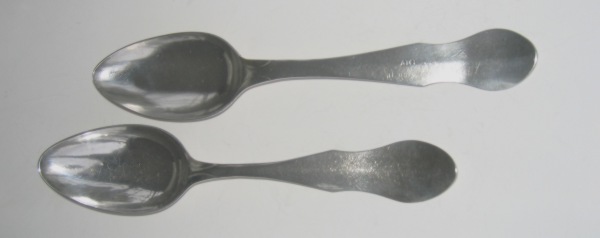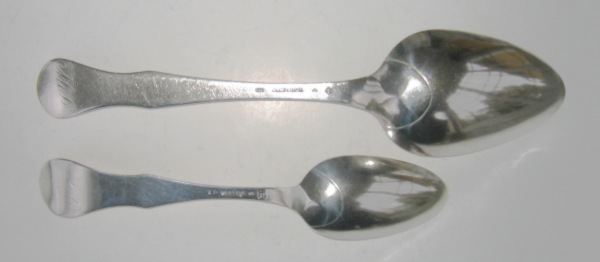by Willand
Ringborg ©
(click on photos to enlarge image)
"THE VIOLIN HANDLE"
development of rococo style in Swedish silver soup spoons
The breeze from south - French influence in art and
silversmithing
In Sweden, the French influence in art and craftsmanship
came to its full expression by the crowning of King Gustaf III
year 1772. He was a strong admirer of continental art and
culture, particularly French, built the Royal Opera, started
academies of literature and art (and sciences). And the French
language became literally "Lingua Franca" in the Swedish court.
Court architects, ebonists, decorators, fountain makers and
fire-works designers were called for service in Stockholm from
abroad. Names like Deprez and Mazrelies have left a strong
heritage in the Stockholm and Swedish art history. The French
new style became highest fashion, but the impact of the previous
baroque style still was present.
This exercise will guide us through the style change in late
18th century and early 19th century. We will not examine
masterpieces and large format silver but mirror the development
in such a minor object as a spoon can show us. But also in this
very common thing as table services, the history of art is
represented.
The anatomy of a spoon
To be familiar with the nomenclature and the discussion of
particulars, let us first examine the spoon details. The
concepts are general for all kind of spoons, in spite of size or
use.
The baroque backlogging
Spoons in silver of course originated in shape and style
from similar ones in bone or wood. They were not prestigious
things for ornamenting but simple, although valuable, tools. The
use of serving sets in the 18th century was still uncommon and
the spoons were the first to be more frequent. When it came to
fork and knife, the guest at the inn was expected to carry a
knife by himself. Forks were uncommon or even unknown. Baroque
ornamenting on spoons was rare, in opposite to tankards,
tumblers and other bigger pieces.
|
|
|
Simple silver spoon,
with central ridge, Stockholm 1761
|
|
|
|
The back of the
stem of the previous spoon, the bowl soldered to
the extended drop of the stem, the "rats' tail"
soldering was at this time abandoned as
obsolete. The full stamp regime of Sweden
introduced 1759 is visible, town mark for
Stockholm, three crowns for silver fineness over
828/000, letter C for 1861 and IPB for the
silversmith J P Berkhan. To the right the older
“aldermans scratch” for silver content testing,
although already obsolete, but was still
scratched as a proof as this method was still in
customers' memory.
|
|
|
|
A later, baroque
style remains at tip of handle, flower engraving,
initials and 1772. The spoon is torn at the side
and the tip of the bowl by long time use
|
The early signs
The curved rococo form appears slowly and is applied to the
handle. The shaping was also functional, when holding the spoon
from under, it is more comfortable to keep the spoon with the
fingers with the curved shape as a support. Still we can see the
remains of older shaping of the bowl to be symmetrically oval.
|
|
|
Weak rococo violin
shape of handle, oval bowl, 1804
|
|
|
|
More of rococo
expression, broader handle and more swing, the
violin form is now appearing stronger, the bowl
is becoming egg formed. Same silversmith, 1811
|
The style in the capital, and in the provinces
The development of taste and style was of course determined
by where the influences struck the country, in the capital
Stockholm. The first to accept was the court, the noble families
and the wealthy strata of the population created a demand on
what was up-to-date. But there were as well other ways for the
influences, silversmiths spent often their time as apprentices
abroad, learnt from maybe more than one master silversmith and
had access to pattern-books. The rococo style was also
introduced by the supply side and this also in Swedish provinces
far from Stockholm. This is why styles appear, and are accepted,
in regions far from the fashionable taste in the capital, which
not seldom was scorned by the rest of the country. And another
tendency was apparent, farmers, bourgeois people and craftsmen
were to put there savings in silver.
|
|
|
Matured rococo,
ridge still there, a minor decoration appears to
mark shoulders, 1806…..
|
Silver, the old savings bank
The savings were commonly stored as spoons, not in full
serving sets with forks and knives, but bought or ordered one by
one. There are many stories of measuring prosperity in counting
spoons. Sometimes a cupboard was arranged with a shelf carved
for silver spoons to hang for visibility, and when the doors
were opened the guests could admire the hosts collection and
wealth. The silver savings role in the household was threefold,
- a capital investment, for use in parties and celebrations and
finally as status symbol. Spending excess earnings in silver was
regarded as non risky, and the liquidity was still there, if one
needed cash for unexpected expenditures, it was just to go to
the nearest pawn-shop and borrow, the silver was still safely
stored.
All spoons presented here – exceptions particularly mentioned –
are from such an area with such habits, a province south of
Stockholm, known for its strong silversmithing tradition,
Ostergotland.
|
|
|
...and an even
broader handle, ridge visible, 1811
|
The full expression
The violin form when it appears in its full expression, the
waist of the handle is slim and the edge to the stem is
emphasised. The back part of the handle close to the terminal
opposite to the bowl is wide and counterweights the form of the
bowl and balances both the shape and function.
|
|
|
Slim waist, wide
handle, 1812
|
|
|
|
Soup spoon, 1813
and serving spoon (ragout spoon) 1842 by the
same silversmith. The rococo style of the handle
of the serving spoon is in this late period not
so emphasised, the shaping is similar in size
with the soup spoon, and function dominates style
expression. The peak of Rococo was over and
replaced by the empire style.
|
Gift spoons
A soup spoon were not only a saving, it was also a common
gift, with a particular intention, it was a memorial that
remained for the receiver’s lifetime, and longer, it had an
undisputed value, and it was also for practical use, even day to
day (there are several examples of single spoons which are torn
by usage and teeth).
The following occasions were typical in giving away a soup spoon:
- christening day to a child (sometimes smaller spoon or
teaspoon)
- wedding
- to a house servant for long service in a household
- funerals
To memorialize the event, the giver often had the spoon
engraved with the initials of the receiver, in the case of
wedding both. The reason for giving away was sometimes engraved.
Funeral spoons are a little special; they were given to the
closest of the relatives to the dead – and to the coffin bearers
- engraved with the full name of the corpse and the date of the
death.
|
|
|
Spoon of rococo
violin style with engraving (translated) and
initials "For loyalty and diligence" APL
GEL, stamped 1813
|
Rococo style reshaped and longstanding
The curved form of rococo gained long popularity and when
the machine made chased silver came in production, the French
impact showed up again and the "French pattern" became
widespread and sold in complete serving sets with forks, knives,
teaspoons, ladles ….
The French pattern, mostly in plated silver, has since long been
one of the most common and widespread table services. And the
era of handicraft and the forerunners is now 200 years away.
|
|
|
Rococo style tea
spoon known as "French pattern", an early
example, south Sweden 1853
|
Finally, a christening spoon, chased with the rococo style
remaining in the shaping of the shell, and here in the wide
spread Kings Pattern.
|
|
|
Dessert spoon to a
child, bite-marks, engraved text on handle (translated)"Christening
gift to C.W.C.Chadier", north Sweden 1848-68
|
Silver spoons from 18th century and beginning of 19th are
fairly popular and with the relatively high production, by
reasons made clear above, the possibility to acquire them is
always present. The older and higher qualities are of course of
more limited supply and the violin variety is, because of its
beauty and age, an attractive collector’s item.
Willand Ringborg © - 2008 -
|
|
|
 ASSOCIATION OF SMALL COLLECTORS OF ANTIQUE SILVER
ASSOCIATION OF SMALL COLLECTORS OF ANTIQUE SILVER











